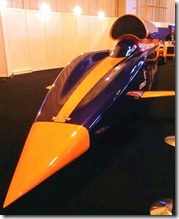 As TCT live 2011 draws to a close, at the NEC in Birmingham, UK, the advancements in 3D printing and additive layer manufacturing come into clearer focus. I think we’ve enjoyed just a glimpse of where these technologies are headed in the future and still can only guess at where the technologies will ultimately lead the industry over the long term. As rapid prototyping (RP) evolves and transfers to volume 3D printing and volume additive manufacturing, there are already many clear examples this technology brings to transform the way main stream manufacturing will evolve and impact consumers.
As TCT live 2011 draws to a close, at the NEC in Birmingham, UK, the advancements in 3D printing and additive layer manufacturing come into clearer focus. I think we’ve enjoyed just a glimpse of where these technologies are headed in the future and still can only guess at where the technologies will ultimately lead the industry over the long term. As rapid prototyping (RP) evolves and transfers to volume 3D printing and volume additive manufacturing, there are already many clear examples this technology brings to transform the way main stream manufacturing will evolve and impact consumers.
The examples are extensive — from building materials, cars, airplane components, household implements, furniture, replacement artificial metal compound human bones through to producing an exact replica of a missing tooth, the list is endless and spread across a broad mass of vertical markets.
 To drive all this technology requires a clear and defined partnership with IT. Associated stages of this process whether its 3D Scanning of an object, rendering images for visualization, creating a design with CAD software or powering a 3D Printer, at the heart of all this technology are 2 key elements, software and IT hardware.
To drive all this technology requires a clear and defined partnership with IT. Associated stages of this process whether its 3D Scanning of an object, rendering images for visualization, creating a design with CAD software or powering a 3D Printer, at the heart of all this technology are 2 key elements, software and IT hardware.
Dell OEM Solutions and Dell Engineering Services attendance at TCT is a clear sign of commitment to this dynamic growing technology and industry. The trending coming out of TCT captures clear defined elements of creating an IT reference architecture to ensure the continued development and support of 3D Printing and Additive Manufacturing. Dell is uniquely placed within this industry to be that ideal supplier.
 By breaking down the process of creating a product or object, Dell OEM and Dell Engineering Services provide the end to end environment of engineering design services to prototyping, providing the pc (Dell Optiplex XE and Latitude) and workstation (Dell Precision) platforms for running CAD software, providing the platform to be embedded within a 3D printer, through to Enterprise services to provide the back end architecture (PowerEdge and Storage) for managing and storing data. So what of the future, where will all this go and what part does IT technology play in the future development of 3D Printing and Additive manufacturing?
By breaking down the process of creating a product or object, Dell OEM and Dell Engineering Services provide the end to end environment of engineering design services to prototyping, providing the pc (Dell Optiplex XE and Latitude) and workstation (Dell Precision) platforms for running CAD software, providing the platform to be embedded within a 3D printer, through to Enterprise services to provide the back end architecture (PowerEdge and Storage) for managing and storing data. So what of the future, where will all this go and what part does IT technology play in the future development of 3D Printing and Additive manufacturing?
In my own personal view, I see the advancements of this industry driving this technology into cloud computingwhere companies can run virtual warehouses full of stock waiting to be printed. Or the possibilities of being able to design a lamp for your home and have it made in the high street 3D printing store or even print it off with your own home 3D printer.
What trends did you see at TCT Live 2011? Where do you see the future impact of IT technology in 3D printing and additive manufacturing?
If your are interested in learning more about Dell OEM Solutions please visit our website, tweet us, or contact our specialized consultants.